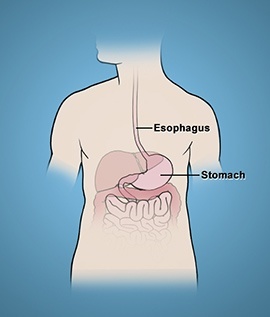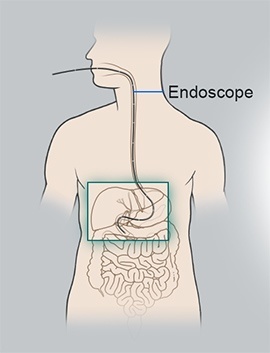Upper Gastrointestinal Diseases Condition

Description
The gastrointestinal tract (GI) extends from the mouth to the anus. It is divided into upper and lower GI tracts. The upper gastrointestinal tract encompasses the mouth, oesophagus, stomach and duodenum, the first part of the small intestine. There are many diseases of the upper digestive tract; some of which include hiatal hernia, gastritis, ulcers, gastro-oesophageal reflux disease (GORD), Barrett's oesophagus, and mouth, oesophageal, gastric and small intestinal cancers.
Causes
Some of the causes of upper gastrointestinal disease include inflammation, smoking and alcohol consumption, long-term use of medications, bacterial infections and excess secretion of digestive fluids.
Impact

Disorders of the upper gastrointestinal tract can significantly impact your health. The symptoms can substantially affect your quality-of-life and psychological wellbeing.Conditions such as GORD can severely interfere with your life as it can hinder a good night's sleep, thereby affecting alertness and productivity the next day. Common symptoms such as heartburn and nausea can significantly interrupt your life.
Anatomy
The gastrointestinal system is a long tube with specialised sections that are capable of digesting and extracting useful components entering the mouth and expelling waste products from the anus. The upper gastrointestinal region of the body encompasses the mouth, oesophagus, stomach and duodenum. Food is chewed and mixed with saliva in the mouth and swallowed. It then enters the oesophagus (food pipe), a long, narrow tube. The food pipe is lined by muscles that expand and contract, pushing food into the stomach. The stomach secretes acid and other digestive enzymes for digestion and stores food before it enters into the intestine. The duodenum is the first part of the small intestine attached to the stomach which helps in digestion.
Symptoms
Symptoms of upper gastrointestinal diseases vary depending upon the condition. Some of the symptoms include difficulty swallowing, nausea, vomiting, heartburn, difficulty in the passage of food, belching, bloating, regurgitation of food and loss of appetite.

Diagnosis
Your doctor may order some of the following tests to diagnose upper gastrointestinal diseases:
- Upper GI endoscopy or gastroscopy: examination of the upper digestive tract using an endoscope, a thin tube with a camera on the end. The endoscope is inserted down your throat and into your oesophagus, stomach or small intestine to detect the problem.
- Upper GI X-rays: involves swallowing a barium preparation, which can be detected through X-rays.
- Twenty four-hour pH monitoring: involves inserting a tube with a sensor through your nose and passing down to near the lower oesophageal sphincter (muscles present at the junction of the oesophagus and stomach)to measure the pH or acidity of the oesophagus. The tube is left there for 24 hours to detect level of acids, which can indicate reflux of stomach's acids into the oesophagus (GORD). A similar procedure can be done with a BRAVO capsule. This is placed in the oesophagus using a gastroscope and stays there for 24 hours before falling off and being passed naturally.
- Oesophageal manometry measures the pressures in the oesophagus to assess how well the muscles function and to make a diagnosis of conditions such as achalasia.
- Biopsy: sample of tissue removed through endoscopy to further examine in the lab.
- Imaging tests such as PET (positron emission tomography), CT (computed tomography), MRI (magnetic resonance imaging) and ultrasound.
Treatments
Treatment depends on the condition and its progression. Several treatment options are available, some of which are mentioned below.
- Medication: prescription and over-the-counter medicines including antacids provide relief to heartburn and indigestion by neutralizing the acids in the stomach. Antibiotics are prescribed to treat infections.
- Lifestyle changes: change in diet, eating smaller and more frequent meals, avoiding smoking and excess intake of alcohol.
- Endoscopic resection: cancerous tissue removal with the help of an endoscope, which is inserted through the mouth and extended to the concerned area. Surgical tools passed through it help in cutting and excising the cancerous tissue. When lesions or cancer involves only the top layer of the oesophagus, the lining is lifted by injecting a solution under it or by suction, and cut by a procedure called endoscopic mucosal resection. Endoscopic resection is non-invasive and does not involve any incisions on the body. It is only suitable for very early cancers.
- Balloon dilation of the oesophagus: A deflated balloon is passed through an endoscope and inflated at the constriction in the oesophagus to allow the free flow of food.
Prognosis
The outcome of treatment varies from person to person. Some may experience mild symptoms while others may have a complete cure. Lifestyle changes and medications can drastically improve your symptoms and your quality of life. Surgical intervention is also associated with optimal results and success in relieving symptoms.
Untreated
If upper gastrointestinal diseases are left untreated, it can lead to serious complications such as severe loss of blood, ulcers, inflammation of the upper digestive tract, pulmonary aspiration, cutting off the blood supply to the stomach, narrowing of the oesophagus and may increase the risk of developing stomach cancer. Some people with significant reflux may develop Barrett's oesophagus, a condition characterised by changes in the oesophageal lining, which can lead to oesophageal cancer.





